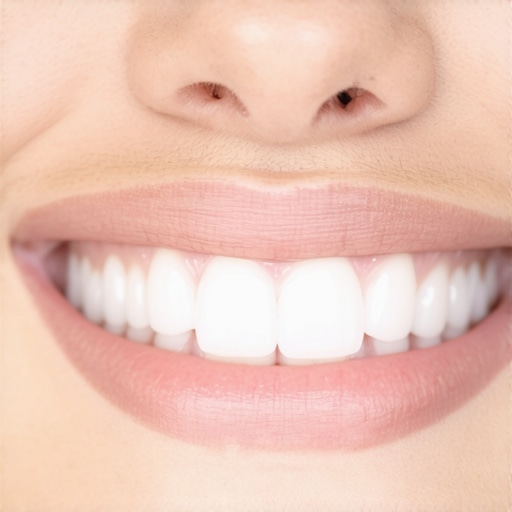Understanding the Synergy of Cosmetic Dental Procedures for Optimal Smile Enhancement
In the realm of modern dentistry, the integration of veneers, Invisalign, and teeth whitening has revolutionized aesthetic and functional smile rehabilitation. As an industry expert, I recognize that each modality offers unique benefits, yet their combined application demands a nuanced understanding of dental biomechanics, material science, and patient psychology. This article explores how these treatments synergize to produce predictable, long-lasting results that align with individual facial harmony.
Advanced Material Science in Veneers: Beyond Aesthetic Enhancement
Contemporary veneers utilize ultra-thin porcelain composites with remarkable translucency and durability, enabling precise customization. Recent innovations have introduced lithium disilicate ceramics that mimic natural enamel’s optical properties, while adhesive technologies have enhanced bonding strength and longevity. Recognizing the biomechanical principles behind veneer placement ensures minimal tooth preparation and maximal preservation of natural structure, aligning with minimally invasive dentistry philosophies (see more on veneer innovations).
Invisalign: The Evolution of Clear Aligners in Complex Cases
Invisalign’s algorithm-driven orthodontic solutions leverage 3D imaging and predictive modeling to achieve precise tooth movements. The latest generation incorporates SmartTrack material, which exerts consistent, gentle forces, reducing discomfort and enhancing patient compliance. For cases involving significant malocclusion, combining Invisalign with adjunctive cosmetic procedures can optimize occlusal function and aesthetic balance. The role of digital planning in Invisalign’s success underscores its status as a cornerstone in contemporary smile makeovers (learn about Invisalign innovations).
Teeth Whitening: Navigating the Complexities of Whitening Agents and Enamel Integrity
Advanced whitening systems utilize carbamide peroxide or hydrogen peroxide concentrations tailored to individual enamel characteristics. Recent research emphasizes the importance of understanding enamel permeability and the potential for transient sensitivity. Incorporating remineralization agents post-whitening can mitigate adverse effects, ensuring enamel resilience. When integrated with veneers and Invisalign, whitening can be strategically timed to maximize aesthetic impact without compromising restorative materials (see top whitening tips for 2024).
How Do We Balance Aesthetic Goals with Functional Integrity in Multimodal Smile Makeovers?
This complex question addresses the core challenge in comprehensive smile design. Achieving harmony involves meticulous diagnostic work, including 3D imaging, occlusal analysis, and patient-specific aesthetic mapping. The interdisciplinary approach ensures that veneers do not compromise occlusal dynamics, while Invisalign aligns teeth for optimal whitening and veneer placement. It’s essential to consider long-term stability, material compatibility, and patient habits in planning. For detailed protocols, consult the complete smile makeover guide.
For practitioners seeking to refine their expertise, exploring advanced courses on digital smile design and biomimetic materials is invaluable. Engage with the community of dental professionals for case sharing and peer-reviewed insights, and always prioritize evidence-based practices to foster patient trust and satisfaction.
If you’re interested in elevating your clinical approach, consider exploring our family dentistry resources and contribute your insights on integrated smile therapies.
Harnessing Digital Smile Design for Precision and Personalization
One of the most transformative advancements in contemporary cosmetic dentistry is the integration of digital smile design (DSD). This technology allows clinicians to create highly accurate, patient-specific visualizations of potential outcomes, fostering a collaborative planning process. By overlaying digital mock-ups with real-time imaging, practitioners can fine-tune aesthetic parameters, ensuring that veneers, Invisalign, and whitening treatments are harmonized with the patient’s facial features and personality (discover more about smile design).
Beyond Aesthetics: Ensuring Functional Harmony in Multimodal Treatments
While aesthetic appeal remains paramount, functional integrity must never be compromised. This is particularly critical when combining veneers with orthodontic interventions like Invisalign. A comprehensive occlusal analysis, including digital bite registration and 3D imaging, helps prevent post-treatment issues such as temporomandibular joint disorder or uneven wear. An expert approach involves adopting a biomimetic philosophy—designing restorations and orthodontic movements that mimic natural biomechanics, thus promoting long-term stability and comfort (see more on functional harmony).
Strategic Timing for Whitening in Multimodal Smile Enhancement
Timing is crucial when incorporating teeth whitening into a comprehensive smile makeover. Typically, whitening is performed after orthodontic alignment but before veneer placement to ensure the optimal shade match and longevity of restorations. Advances in whitening agents, such as low-peroxide formulations combined with remineralization protocols, allow for safe, effective results without compromising enamel integrity or restorative materials. This strategic sequencing maximizes aesthetic impact while maintaining structural health (explore expert whitening tips).
How Can We Leverage Emerging Technologies to Further Personalize Smile Makeovers?
Emerging innovations like artificial intelligence-driven treatment planning and augmented reality visualization hold the potential to revolutionize personalized dental care. These tools enable practitioners to simulate various aesthetic outcomes in real-time, tailoring treatments more precisely to individual facial dynamics and patient preferences. As research highlights, integrating these technologies can significantly boost patient satisfaction and treatment predictability (see the latest research on AI in dentistry).
For practitioners eager to deepen their expertise, exploring advanced courses on digital workflows and biomimetic materials is invaluable. Sharing insights with peers through professional forums can foster innovative approaches and elevate standards of care. Always remember, a patient-centric, evidence-based methodology ensures the best results and enduring trust.
If you’re interested in refining your approach to smile design, consider visiting our contact page for personalized consultations and resources.
Integrating Biomimetic Principles for Long-Term Stability in Multimodal Dental Treatments
Achieving a harmonious balance between aesthetics and function in comprehensive smile makeovers necessitates a deep understanding of biomimetic principles—an approach that emphasizes designing restorations and orthodontic interventions to mimic natural dental biomechanics. Such integration ensures resilience against functional stresses and minimizes risks of post-treatment complications like occlusal trauma or periodontal issues. Advanced biomimetic materials, such as resin nanoceramics, offer excellent wear compatibility and bonding strength, aligning with the natural wear patterns of enamel (see detailed research on biomimetic materials).
How Do We Incorporate Dynamic Occlusal Analysis for Predictive Stability?
Dynamic occlusal analysis, utilizing technologies like T-Scan or digital bite registration, allows clinicians to visualize occlusal forces in real-time, identifying potential points of overload or premature contacts. Incorporating this data into treatment planning ensures that veneers and orthodontic movements are executed within biomechanical safe zones, reducing the likelihood of material failure or temporomandibular joint (TMJ) dysfunction. This proactive approach exemplifies a shift from reactive to predictive dental care, emphasizing long-term stability over short-term aesthetic gains (research on dynamic occlusal analysis).
Advanced Digital Workflows for Precision Customization
The evolution of digital workflows, including CAD/CAM and 3D printing, empowers clinicians to craft highly precise, patient-specific restorations and orthodontic appliances. These technologies facilitate meticulous control over morphology, translucency, and shade, aligning restorations perfectly with individual facial features. Moreover, integrating digital smile design with virtual articulation allows for simulation of functional movements, helping to preemptively address potential occlusal interferences before physical implementation (see latest advancements in digital dentistry).
What Role Does Patient-Specific Digital Modeling Play in Predicting Outcomes?
Patient-specific digital modeling harnesses high-resolution intraoral scans and facial scans to generate comprehensive 3D representations of the patient’s anatomy. This allows for virtual simulation of treatment outcomes, including the impact of different restorative materials, orthodontic movements, and whitening protocols. Such modeling fosters shared decision-making, setting realistic expectations while optimizing treatment sequences. The ability to visualize multiple scenarios enhances predictability and patient satisfaction (study on digital modeling efficacy).
Emerging Technologies: Augmented Reality and AI for Personalized Treatment Planning
Emerging technologies like augmented reality (AR) and artificial intelligence (AI) are poised to further personalize smile makeovers. AR enables real-time visualization of proposed changes overlaid onto the patient’s face during consultations, fostering better understanding and engagement. AI algorithms, trained on vast datasets, can analyze patient-specific factors—such as facial proportions, occlusal dynamics, and aesthetic preferences—to generate optimized treatment plans. These advancements not only streamline workflows but also enhance predictability and customization, leading to higher patient satisfaction (latest AI applications in dentistry).
For practitioners committed to elevating their expertise, engaging in specialized courses on digital treatment planning, biomimetic materials, and emerging technologies is essential. By embracing these innovations, clinicians can push the boundaries of traditional cosmetic dentistry, delivering outcomes that are both stunning and functionally robust. To explore tailored resources and advanced training opportunities, visit our contact page for personalized guidance.
Innovative Biomimetic Approaches: Crafting Resilient and Natural-Looking Restorations
Emerging research emphasizes the integration of biomimetic principles in restorative materials, such as resin nanoceramics and bioactive composites, which emulate the natural biomechanics of enamel and dentin. These advanced materials facilitate not only aesthetic excellence but also long-term durability against functional stresses. Implementing layered restorations that replicate natural translucency and enamel stratification enhances both visual harmony and structural resilience.
Harnessing 4D Imaging for Dynamic Functional Analysis
Beyond static imaging, 4D technologies incorporate temporally dynamic data, capturing real-time functional movements of the jaw during speech, chewing, and parafunctional habits. This comprehensive analysis enables clinicians to predict potential occlusal interferences and wear patterns, allowing for preemptive adjustments in treatment planning. Such precision ensures that veneers, orthodontics, and whitening protocols operate synergistically without compromising occlusal stability (see more on 4D imaging advancements).
What Are the Capabilities of AI-Driven Predictive Modeling in Complex Smile Design?
Artificial intelligence leverages vast datasets and machine learning algorithms to simulate myriad treatment scenarios, optimizing case-specific parameters such as facial proportions, occlusal forces, and aesthetic preferences. AI-driven models facilitate precise predictions of treatment outcomes, reducing uncertainties and enhancing patient engagement through virtual reality interfaces. This integration of AI not only refines treatment accuracy but also accelerates decision-making processes, elevating standards of care.
How Can We Integrate Augmented Reality for Real-Time Patient Engagement?
Augmented reality (AR) technology enables practitioners to overlay virtual smile designs directly onto the patient’s facial features during consultations. This immersive visualization fosters informed consent, aligns patient expectations, and enhances collaborative planning. As AR continues to evolve, its application in interactive treatment previews promises to revolutionize patient-centered care by making complex aesthetic predictions tangible and accessible.
For dental professionals eager to pioneer these innovations, engaging in specialized training on digital workflows, AI integration, and AR applications is essential. Embrace these cutting-edge tools to elevate your practice and deliver unparalleled customized care. Explore our advanced courses and resources at our education portal.
Expert Insights & Advanced Considerations
Embracing Digital Synergy
Integrating digital smile design with AI-driven treatment planning enhances precision, reduces uncertainties, and fosters personalized patient experiences, setting new standards in aesthetic dentistry.
Biomimetic Material Innovation
The adoption of bioactive composites and layered restorations that mimic natural enamel and dentin is crucial for durable, harmonious results that stand the test of time and function.
Dynamic Functional Analysis
Employing 4D imaging and digital bite analysis allows clinicians to anticipate occlusal stresses and prevent post-treatment complications, ensuring long-term stability and patient satisfaction.
Augmented Reality as a Communication Tool
AR technology provides immersive, real-time visualization of proposed smile enhancements, fostering better patient understanding, engagement, and consent.
Emerging AI Applications
AI algorithms facilitate case-specific predictive modeling, optimizing aesthetic and functional outcomes and streamlining clinical workflows for complex smile makeovers.
Curated Expert Resources
- Journal of Digital Dentistry: Offers cutting-edge research on digital workflows, AI integration, and biomimetic materials, essential for staying ahead in aesthetic dentistry.
- American Academy of Cosmetic Dentistry (AACD): Provides comprehensive educational resources, case studies, and guidelines on advanced cosmetic procedures and technology adoption.
- Dental Trainee & Continuing Education Platforms: Platforms like Spear Education and the Dawson Academy deliver specialized courses on digital smile design, biomimetic materials, and functional analysis.
Final Expert Perspective
As the landscape of aesthetic and functional smile enhancement evolves rapidly, embracing innovations such as digital workflows, biomimetic materials, and augmented reality ensures clinicians deliver predictable, durable, and personalized results. The integration of these advanced technologies represents the future of comprehensive smile makeovers, elevating patient care to unprecedented levels. For practitioners committed to excellence, engaging with these resources and continuously refining skills is vital. Explore our contact page to discover tailored strategies and advanced training opportunities that can transform your practice and patient outcomes.

